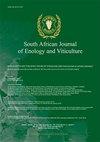Phylogeny of Holocacista capensis (Lepidoptera: Heliozelidae) from Vineyards and Natural Forests in South Africa Inferred from Mitochondrial and Nuclear Genes
IF 1.1
4区 农林科学
Q4 FOOD SCIENCE & TECHNOLOGY
引用次数: 0
Abstract
In South Africa, the family Heliozelidae in the order Lepidoptera is restricted to four known species. The grapevine leaf miner, Holocacista capensis, feeds between the epidermal layers of a grapevine leaf, predominantly along the leaf margin. A final instar larva will descend from the blotch mine/gallery to attach its cocoon casing (constructed from the epidermal layers of the mined gallery) to any object below the infested leaf. Five monophyletic clades and a polyphyletic group have been identified within the Heliozelidae, using a mitochondrially encoded gene cytochrome c oxidase I (COI) and a nuclear gene, histone 3 (H3). An exploratory study of the genetic diversity within H. capensis populations was conducted using these genes. The phylogenetic analyses of COI indicate that H. capensis that are currently being collected from South Africa fall within three clades/haplotypes, of which one is well supported and contains only one species from Gauteng, and one has three specimens from two different areas in the Western Cape province, while 80% belong to haplotype 1 (H1). The current study can be used as a starting point for future DNA-based studies aimed at gaining insight into possible patterns of diversity in H. capensis to confirm switching from native to commercial grapevine hosts. However, more samples need to be collected from different areas in South Africa.从线粒体和细胞核基因推断南非葡萄园和天然林的全新紫锥蝽的系统发育(鳞翅目:紫锥蝽科)
在南非,鳞翅目的Heliozelide科仅限于四个已知物种。葡萄潜叶虫Holocacista capensis主要在葡萄叶的表皮层之间觅食,主要沿着叶缘。最后一龄幼虫将从斑点矿井/廊道下降,将其茧壳(由采出的廊道的表皮层构建)附着在受感染叶片下方的任何物体上。利用线粒体编码的基因细胞色素c氧化酶I(COI)和核基因组蛋白3(H3),在Heliozelide中鉴定出五个单系分支和一个多系群。利用这些基因对山核桃种群的遗传多样性进行了探索性研究。COI的系统发育分析表明,目前从南非采集的H.capensis属于三个分支/单倍型,其中一个分支/单倍型得到了很好的支持,仅包含豪登省的一个物种,另一个分支和单倍型包含来自西开普省两个不同地区的三个标本,而80%属于单倍型1(H1)。目前的研究可以作为未来基于DNA的研究的起点,旨在深入了解H.capensis的可能多样性模式,以确认从本地葡萄宿主向商业葡萄宿主的转变。然而,还需要从南非的不同地区采集更多的样本。
本文章由计算机程序翻译,如有差异,请以英文原文为准。
求助全文
约1分钟内获得全文
求助全文
来源期刊
CiteScore
2.50
自引率
7.70%
发文量
1
审稿时长
>36 weeks
期刊介绍:
The South African Journal of Enology and Viticulture (SAJEV) publishes full-length original Research Papers, Research Notes and Review Papers on all subjects related to enology and viticulture. The SAJEV does not accept articles published in, or submitted to, other journals.

 求助内容:
求助内容: 应助结果提醒方式:
应助结果提醒方式:


